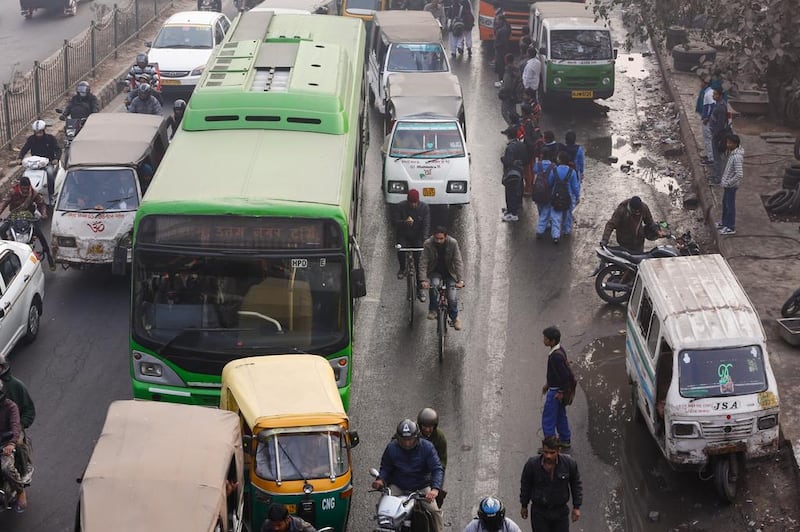NEW DELHI // When Avikal Somvanshi was a boy in Allahabad, a town in Uttar Pradesh, he cycled five kilometres each way to school. Later, in his first job as an architect in Pondicherry, he pedalled about two kilometres to and from work every day.
But Delhi was a different matter.
After Mr Somvanshi moved to the Indian capital in 2012, to work for the non-profit Centre for Science and Environment as a programme officer, he did not get on a bicycle for six months.
“I was a little scared,” he admits.
In 2008, according to the most recent study by the ministry of urban development, cyclists made roughly 2.8 million trips every day in Delhi – nearly as many as cars, which made 3 million trips. The number of cars in Delhi has climbed even higher since then. With 9 million registered vehicles, Delhi has more motor vehicles than Chennai, Mumbai and Kolkata combined.
Mr Somvanshi says cyclists feel sidelined amid all the traffic.
“Drivers don’t know how to behave with them, what kind of space to give them,” he says. “They shout at cyclists if they aren’t pedalling fast enough, or they stare them down.”
More worrisome are the city’s wide avenues, which encourage speeding beyond the average speed limit of 50kph.
Seventy-eight cyclists died in 2012 on Delhi’s roads, according to the National Crime Records Bureau’s most recent statistics.
Although this fatality count is far lower than the 205 who died in cars or 489 who were killed on motorcycles that year, it is enough to deter cyclists.
“Cycles are simply unsafe in traffic today,” says K Ravinder, a researcher at the federal government’s Central Road Research Institute. “This has contributed to a decline in cycling.”
Mr Somvanshi eventually plucked up the courage to ride the four kilometres to his office every day, a trip that takes him 15 minutes. He says cycling allows him to avoid choked arterial roads, gives him a daily dose of exercise, and shrinks his carbon footprint.
But he still has to cope with the brutal heat from April to October, forcing him to jump into the shower as soon as he gets to work and to carry a change of shirt at all times.
On top of that, the sharp increase in motor vehicles has made Delhi among the most polluted cities in the world.
The pollution problem is forcing the government to reduce motorised traffic as well as encourage cyclists to return to the roads.
Last January, the state-owned Delhi Metro launched a bicycle sharing scheme, allowing commuters to rent bicycles from an automated rack at stations for 10 rupees (Dh0.55) an hour, and return them to the same rack or another in a different location before boarding a train to their next destination.
The facility is available at only seven of the 160 Metro stations, but Delhi Metro intends to gradually install bicycle rentals at more stations.
These bike racks are useful, Mr Somvanshi says, but there are not enough places around the city to return the bikes, making it necessary to return to a metro station to drop them off.
In the matter of bicycle lanes too, he says, the government appears to be misguided in its thinking.
“There are these vast corridors of cyclists from low-income areas to business districts, but Delhi’s cycle lanes don’t run along these stretches at all,” he says. “There is no point, for instance, to the cycle lanes demarcated in ritzy central Delhi, where few people cycle.
“And where the cycle lanes do exist, there’s no enforcement to make sure cars and motorcycles don’t occupy them.”
If Mr Somvanshi wanted, he could certainly buy a motorcycle, or perhaps even a car. But thousands of other cyclists in Delhi cannot afford these options.
Anil Kumar Jha, a 53-year-old with a handlebar moustache, works for G4S, a company that provides security guards for private residences and commercial buildings. Every morning he cycles 10km from his home in Delhi’s Khanpur locality to Sarvodaya Enclave, an affluent neighbourhood where he spends the day stationed outside an apartment complex.
“It takes me half an hour in the morning, and around 45 minutes in the evening, when there’s more traffic,” Mr Jha says.
He points to his lean figure and laughs. “See how fit it keeps me? I know men my age who look much older.”
While he enjoys the ride, the air pollution is a problem, Mr Jha says. In his village in Bihar he has no breathing problems, but in Delhi, he has been advised by his doctor to use an inhaler once or twice a day.
He has been in an accident only once – in 2007, he was hit by a car near Sarvodaya Enclave that drove straight ahead in an automobile lane reserved for turning.
It knocked the wind out of him, and his elbows and knees bore ugly abrasions, but his bicycle did not suffer damage.
“The traffic is unnerving,” Mr Jha says. “In my 20 years in the city, it has multiplied. I can feel it. But I don’t have too many other choices. The buses are always full, and they take much longer because of the jams. The cycle is really my only solution.”
ssubramanian@thenational.ae





